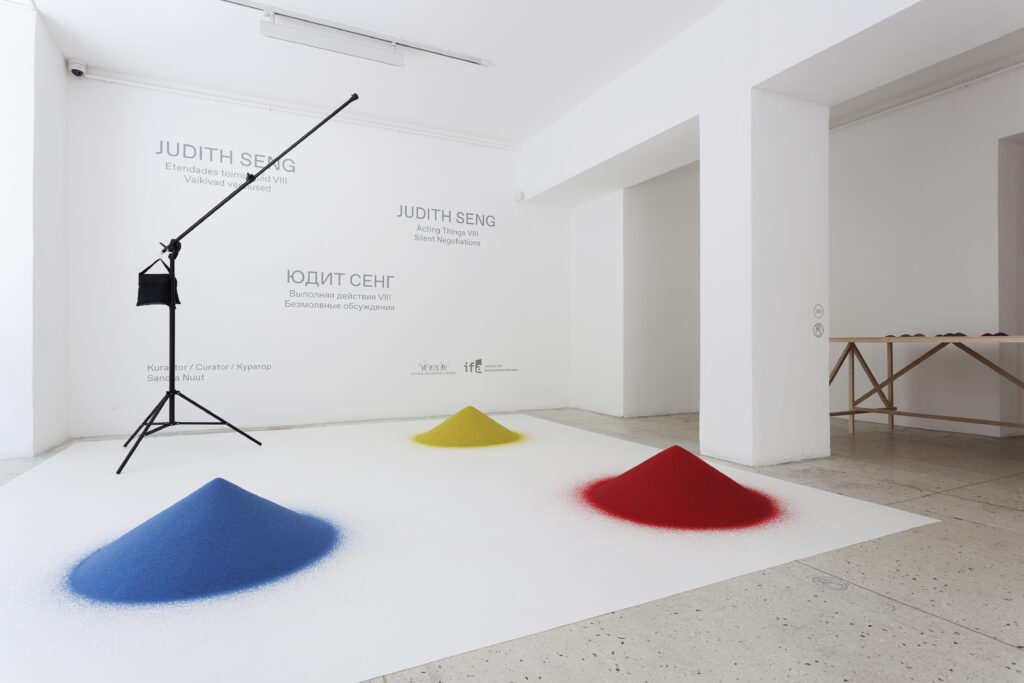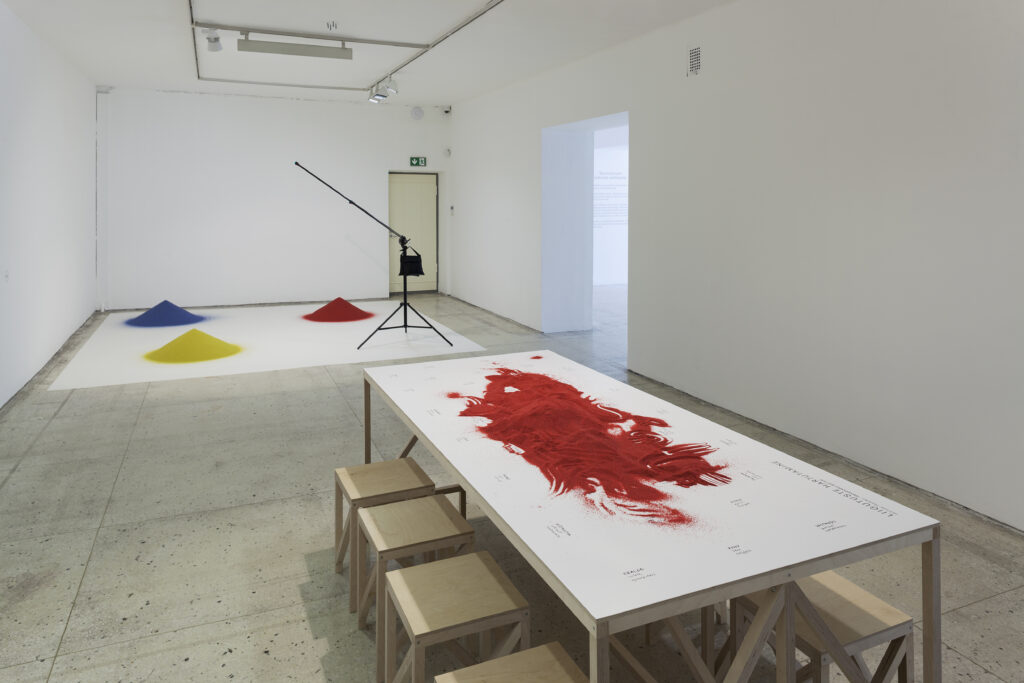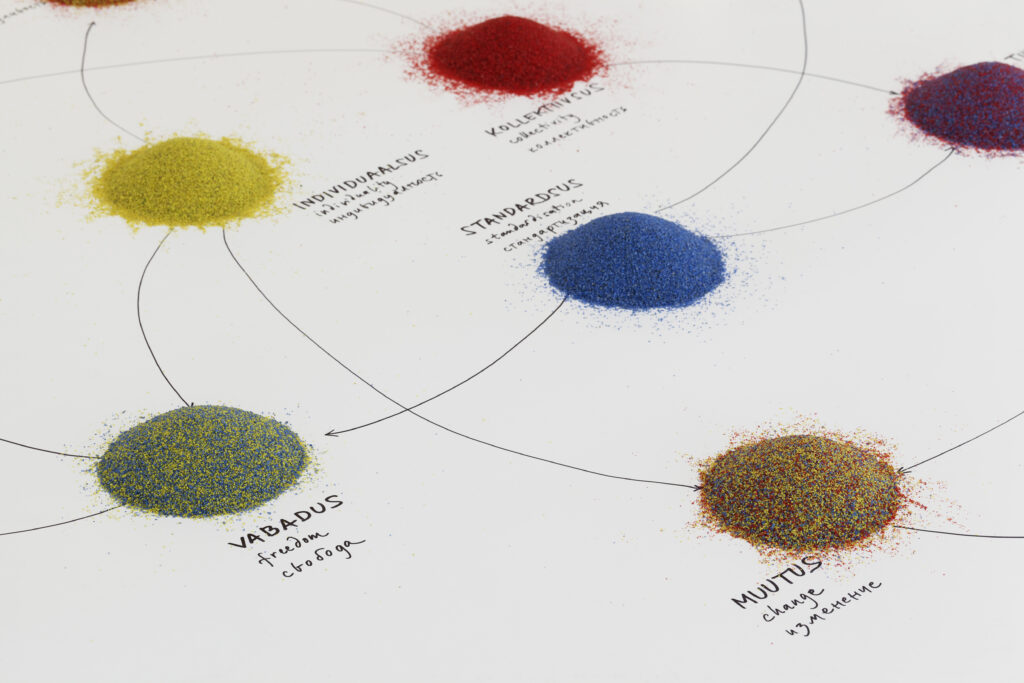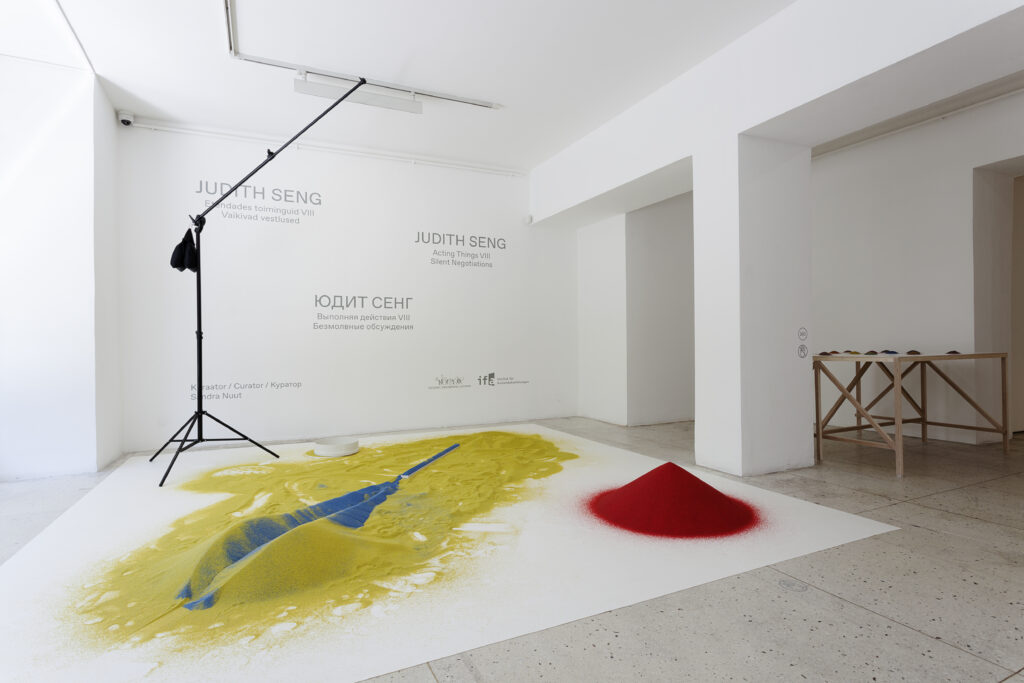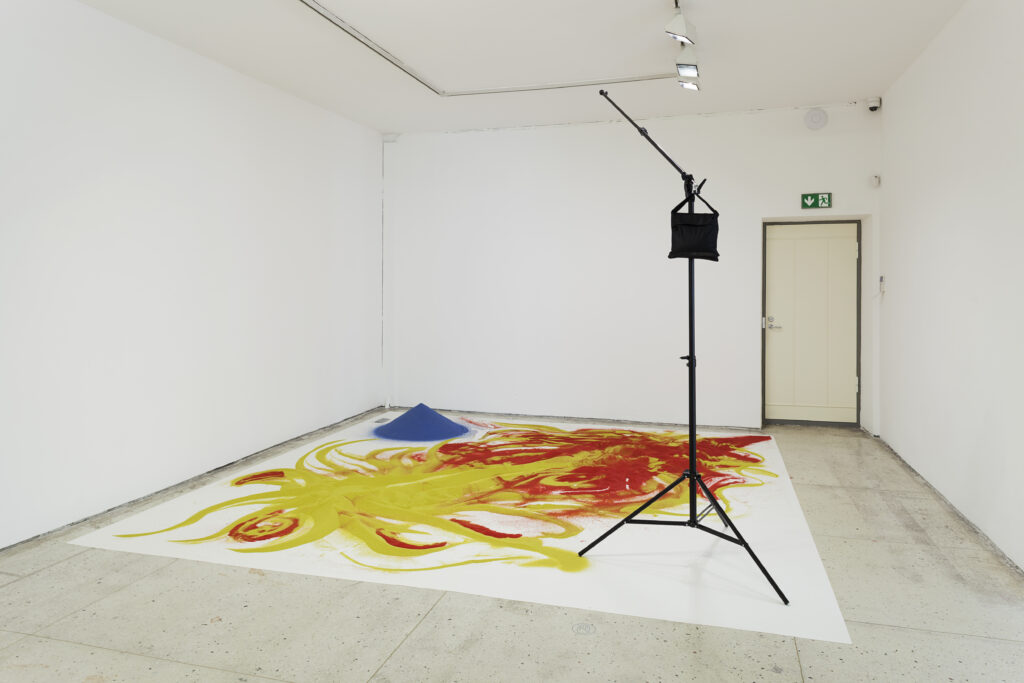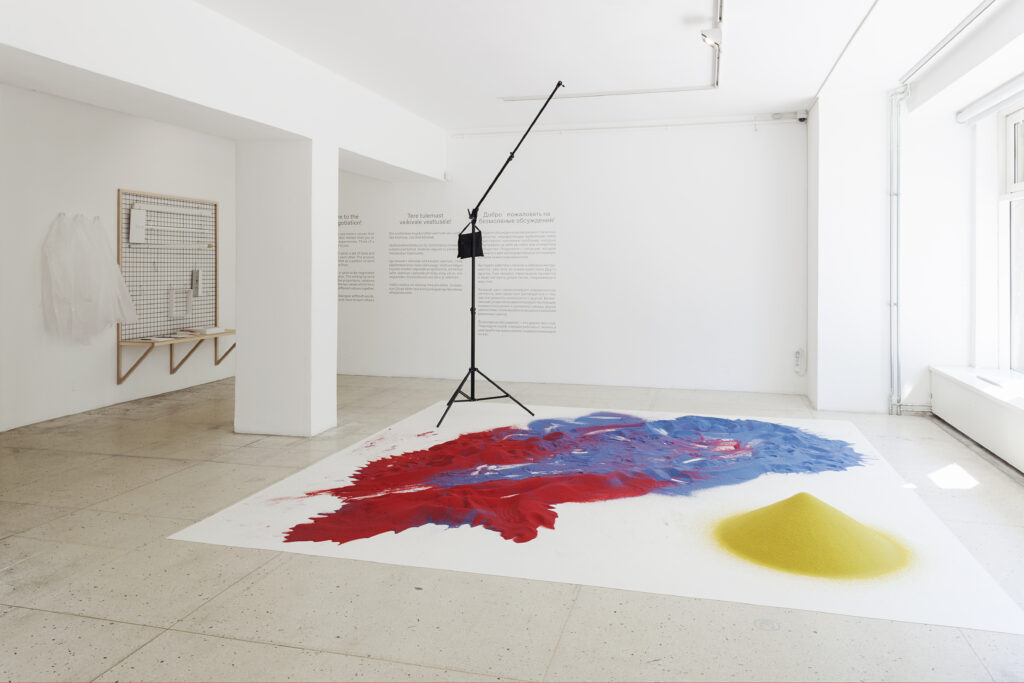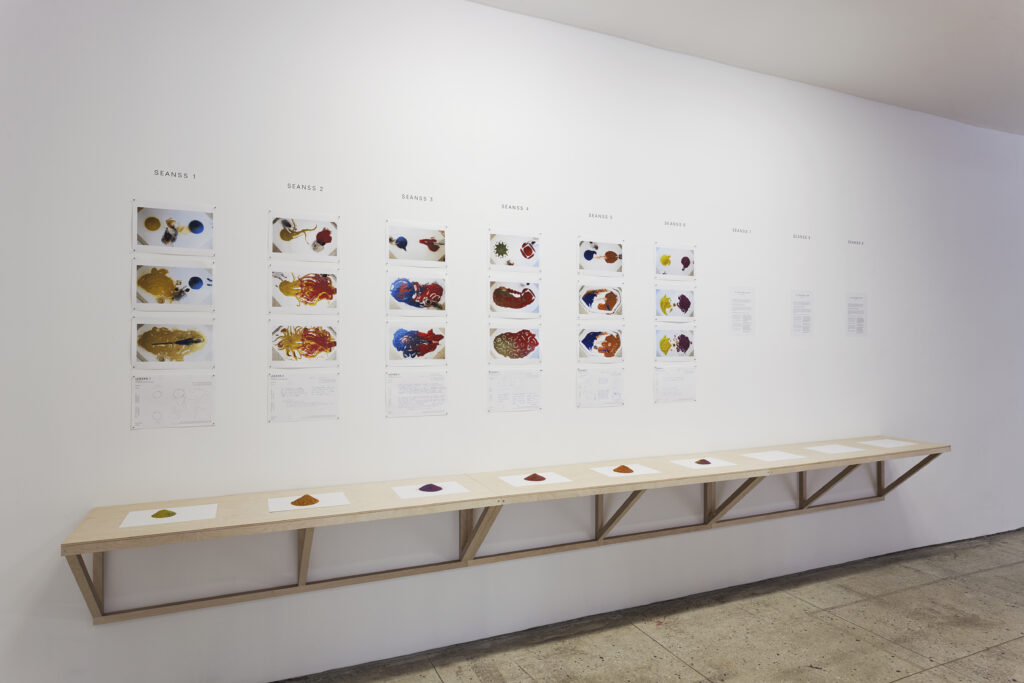Acting Things VIII – Silent Negotiations (2021) by Judith Seng and curated by Sandra Nuut was an exhibition that featured three silent negotiation sessions with 18 participants at the Tallinn Art Hall Gallery.
Curatorial text
Judith Seng’s Acting Things VIII – Silent Negotiations (2021) is a performative installation that invites participants to negotiate with colourful sand and social values to learn and unlearn preconceived notions, relations and boundaries – and to see how they appear and dissolve through movement and in sand. Silent Negotiations is the eighth installation in the Acting Things experimental production series first conceived by Judith Seng in 2011, in which process design is explored with elements and methods of the performing arts. Seng’s initial question with the series is as follows: “What if we looked at production processes as if they were a dance, a play, a ritual?”1
I first encountered Judith Seng’s work Acting Things VII – School of Fluid Measures in 2018 at the 4th Istanbul Design Biennial, A School of Schools: Design As Learning, curated by Jan Boelen with Nadine Botha and Vera Sacchetti. Within the biennial on design and learning, the installation explored learning as something that is not fixed or quantifiable but rather a fluid ever-changing and becoming process. Just like learning, the public and public sphere function as ever-altering and transforming through collective making and unmaking.
Acting Things VIII – Silent Negotiations, an installation of nine sand piles, is also a workshop and an archive, where participants in pairs discuss one public matter silently with two assigned piles of sand in order to have a silent conversation and then reflect on the process. Upon entering the gallery at the beginning of the exhibition, the sand piles are presented in the form of distinct primary colours, with each bearing one social value that will soon be mixed. The colours and the values – such as freedom, individuality, responsibility and more – are studied but also blended in sessions (a small portion of the freshly mixed sand will be presented in the archive section of the installation). By the end of the exhibition, none of the piles will have one distinct colour but rather a mixture of the different primary grains and values. In this we can find patterns that are in place via dialogical movement in sand where any fixed object, number or value dissolves into situations through scored interactions. Through this learning process we highlight questions that we come up against but also continuously shape. Feminist scholar and writer Sara Ahmed writes about brick walls that diversity work practitioners often meet, although there is never a real wall in front of them. It is about what this work feels like. “A wall is an effect of coming up against.”2 We as citizens create the status quo, whether actively or not. The norms and the boundaries may also be set before and without including you. One’s access or lack of rights, security and resources can be the result of being born on the “right” or “wrong” side of the border.3 Do we acknowledge the “walls” or “norms” that include or seclude us in the making of the public? How do we perform boundaries? Perhaps the sand in the installation provides us with an opportunity to act out and thus rehearse and practice new boundaries?
One of the starting points of this exhibition is the polarisation that has arisen in the context of the new wave of populism, and has subsequently reduced and narrowed the range of public political discourse.4 Maybe the clear coloured grains represent utopian clear views? Today, in the midst of various lockdowns, the role of the public sphere is becoming complex, as the opportunities to meet are reduced and the public and private are being enacted at homes or digitally from homes. And there, in our bubbles, which may be comfortable but also may amend our collective development stagnant, is the need to study the status quo because neither our differences nor our boundaries disappear. “The only alternative is to recognise and learn to value difference despite its difficulties; to learn through practice, through trial and error, how, slowly and sometimes painfully, to negotiate difference,” writes sociologist Stuart Hall.5
Seng’s work reflects the paradigm changes in design from products to processes, from objects to systems and from the material to immaterial, and relational design, which concern “interactions between humans, objects, buildings, cities, countries and networks.”6 Furthermore, her socio-material approach is beyond the binary of material and immaterial, though it acknowledges and addresses the dynamic interplay. Through Seng’s directed processes of negotiating, participants have the opportunity to experience conversation physically and accentuate other means of expressing with moving, touching, shaping, seeing and more. She tries to make our daily situations understandable as works of design – works that have been shaped, have a form and have a way of being performed.7 Seng’s installation perhaps physically manifests the words of Swiss sociologist Lucius Burckhardt, who wrote that design is invisible and design deals with the invisible, meaning that the importance lies between the objects and relations. In the 1980s, Burckhardt also found that “design must broaden its scope and embrace socio-design: a way of thinking about resolving problems that results from coordinated changes made both to roles and to the objects.”8 Seng has herself participated in one of the negotiations and reflects: “My first impulse was that Responsibility would do this big circle, like a cage around Freedom. But through the negotiation process, I figured out that instead it has to act like the skeleton that stabilises from the centre. I probably could also have figured this out through thinking, but here I experienced it.”9
As you might have understood, we do not look to solve any issue in the public sphere but instead to learn, scratch the surface, provide a test set-up, and offer a design to investigate in order to see and explore patterns via our own choreography performed in our everyday life. The negotiating workshops aim to make our sociomaterial production visible via bodily engagement. The materiality of the negotiation process helps us to become conscious of our own ways of performing and potentially learn something. “We learned from Mrs Dalloway that you can be hit by something before you become conscious of something. If we are hit by something [or as in the installation perform this something while negotiating], again and again, our body might register this […].”10 It is a personal and collective learning experience and a chance to exercise subverting the status quo while employing empathy and solidarity through intuitively observing, touching and moving together.
Sandra Nuut
Bibliography:
1 Seng, Judith. “Acting Things.” Accessed 19 March 2021, http://www.judithseng.de/projects/acting-things/index.html.
2 Ahmed, Sara. Living a Feminist Life. Durham, London: Duke University Press, 2017.
3 Keshavarz, Mahmoud and Shahram Khosravi. “The Magic of Borders”, e-flux, https://www.e-flux.com/architecture/at-the-border/325755/the-magic-of-borders/.
4 Bratton, Benjamin H. “So Heavy Grasshoppers: Allochtonous Notes on Populism”. In Para-Platforms: On the Spatial Politics of Right-Wing Populism, edited Markus Missen & Zoë Ritts, 43. Berlin: Sternberg Press, 2018.
5 Hall, Stuart. “Cultural Diversity” in Courageous Citizens. How culture contributes to social change, edited Bas Lafleur, Wietske Maas, Susanne Mors, 29. Amsterdam: Valiz, 2018.
6 Boelen, Jan. Nadine Both, Vera Sacchetti eds. Design as Learning. A School of Schools Reader. Amsterdam: Valiz.
7 “Meditated Meaning”, Disegno, 15 May 2019, https://www.disegnodaily.com/article/mediated-meaning.
8 Burckhardt, Lucius. Design is Invisible. Basel; Birkhäuser Verlag GmbH, 2017.
9 Seng, Judith. Correspondence via email, 29 March 2021.
Photos by Paul Kuimet, Tallinn Art Hall
